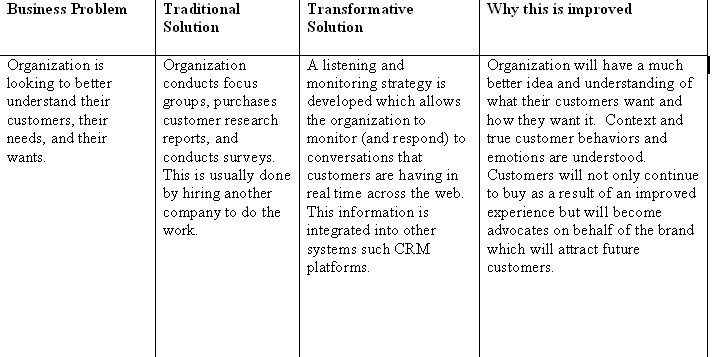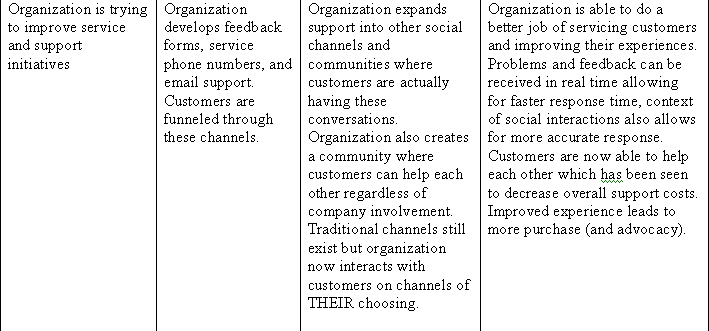 (White to move and Mate in 2, can you figure out the answer?)
(White to move and Mate in 2, can you figure out the answer?)
There’s been a lot of talk about what SCRM is (social customer relationship management) and how it should be defined. There has also been a lot of conversation around Social CRM from a technology standpoint in terms of vendor offerings. I’ll admit I’ve engaged in the definition wars as well as it’s hard to resist however I’ve come to realize that none of this matters because at the end of the day we are looking to solve a business problem that organizations are faced with. Nobody asks for a Social CRM solution and nobody has a Social CRM problem. What we are dealing with is an evolution of business.
There hasn’t been much conversation around business use cases and specific business problems that Social CRM helps solve. I thought I’d start the conversation, at least on this site.
I actually started writing far more than I should have and really scaled everything back to what I hope is an easy to understand yet comprehensive explanation of some of the business challenges that Social CRM is seeking to solve and how. I probably should have put greater emphasis on the “people” and “strategy” aspect of making this work so I’ll clarify that here. Every solution needs to be supported by an existing CRM framework, meaning people, process, and technology. I don’t want anyone to read this thinking that just deploying a monitoring tool or a community platform is going to solve anything because it won’t. Technology is always an enabler and nothing more.
I used the term “Transformative Solution” because I believe that the title of the framework for social business that Mike Fauscette and his team created at IDC is spot on, what is the title you ask? “Social Business Framework: Using People as a Platform to Enable Transformation” (personally I would have used the term “empowering” instead of “using” but you get the point, either way it’s definitely worth a read). I don’t want to comment on the actual framework yet because I need to spend more time reading through it but at first glance it made sense. Let’s get back to the point of business evolution or transformation and why this is significant. In order to understand this evolution or transformation I think it makes sense to start off with a business problem, a traditional approach to solving that problem, an evolved or transformative approach to solving that same problem, and a brief explanation of why this transformative approach is an improvement.
I really wanted to go through the 18 Social CRM use cases that Jeremiah Owyang from Altimeter created but honestly I just didn’t have the energy so I thought I would give it a go with the two examples below (just to get started).


What I put together is not perfect but I really just wanted to show how Social CRM is seeking to solve existing business challenges which organizations are faced with. Social CRM isn’t about social media and there is no magic voodoo here, it’s simply a different approach to solving a business problem that has and will always exist within most organizations around the world. In fact, I think it would be great for everyone to contribute some ideas to this. If you have a business problem your organization is looking to solve or have an idea of how Social CRM can help solve an existing (or new) business problem, then leave a comment below.
I’m sure many of you reading this can add to what I started or perhaps make changes/edits to what I have put together. I actually think this approach makes a lot of sense for vendors who are looking to sell their tools and/or products.
So what do you think? Does this make sense? Are you able to see the difference between a traditional and a transformative solution to the same business problem? I welcome any feedback to improve this as I’m hoping to incorporate more tables and similar breakdowns in future posts.

Yes, this made sense. I think before you begin any analysis, you need to do three things: identify the business problem, issue or opportunity, define what your response is going to be and the be willing to adapt to your findings. It seems you have to a starting point to frame your analysis or your just monitoring conversations.
Da, acest lucru a făcut sens. Cred că înainte de a începe orice analiză, ce trebuie sa faci trei lucruri: a identifica problema de afaceri.,traditiile, banii.
The benefits of social CRM for me are more about motivating your staff and retaining good employees by giving them clearer visibility across the business, making them feel that they are part of the business and that their voice is heard. The social CRM software that I think fits this remit is ClickHQ (http://www.clickhq.co.uk) it gives a businesses staff a face and a voice and empowers them with information across all touch points with their customer base with just one click.
I personally find the Social CRM platforms most successful when they are a combination of both internal and external networks. That way the company not only is able to engage it's customer but also employees.
I see your point about a transformative solution VS a traditional solution. The transformative one involves a more personal touch, directly getting immersed in the stream of conversation that consumers are creating. Purchasing customer research reports and creating surveys are just too far-removed from the constantly updated feedback available on the WWW.
Finally! thank you Jacob for saying out loud what many of us think: what SCRM is and what it should do does not matter!
In my opinion, SCRM should be different for each company and should in no way be seen as an universal solution to every company's problems when dealing with its customers (as CRM has been and still is perceived by many)
In conclusion, SCRM can only be as good as the company using it!
Very well put, if you don't have a clear grasp of why are you doing what you are doing, you really aren't going to see any benefits long term.
Hi Gabriel,
Thanks for stopping by and leaving your 2 cents. I think your comment at the end sums it all up:
“SCRM can only be as good as the company using it! ” well said.
Of course, balancing the internal and external collaboration pieces is key. Both need each other.
QxP should just about do it 🙂
Oh – then the obvious Rook move….
yeah right…
Your viewpoint of business is interesting. Since I am also a manager, I am allowed to refer to it. Tahnk You.
http://555.mond.jp/